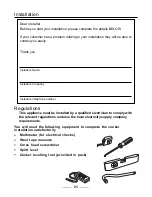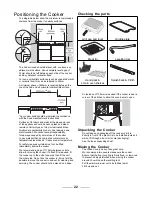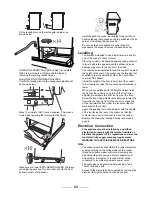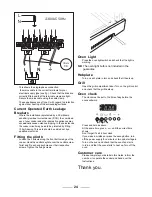
17
Troubleshooting
My hobplates are going rusty
The cast iron hobplates will rust if left wet.
Don’t put wet pans onto the plates. If you
spill liquid on a hobplate clean it with a damp
cloth, then switch the plate to the lowest
setting for a few minutes to dry. Oil the
hobplates sparingly about once a month with
a few drops of cooking oil then rub over with
a cotton cloth. Take care NOT to oil the outer
stainless bezel or the red discs on any of the
hobplates.
The red spots are coming off my hobplates
The red disc is an identifying mark for high-
speed hobplates. It may wear away with use
but this will not affect hob performance in any
way.
The trims on my hobplates are discolouring
The bright metal hobplate trims may turn
a straw colour with use - this is perfectly
normal.
Grill not cooking properly
Are you using the pan and trivet supplied with
the cooker? Is the pan being used on the
runners, not the fl oor of the compartment? Is
the grill tray pushed fully back to stop?
Steam is coming from the oven
During cooking, food naturally produces
steam, particulary when cooking foods with
high water content (e.g. oven chips). There
may be some steam visible at the grille at the
rear of the hotplate. This is perfectly normal.
Steam can condense to water droplets on
the cool outer trim or the oven door. It may be
necessary during cooking to wipe away any
moisture with a soft cloth. This will also help
to prevent soiling and discolouration of the
oven exterior by cooking vapours.
Take care when opening the oven door as
there may be a momentary puff of steam
when the oven door is opened. Stand well
back and allow any steam to disperse.
The oven fan is noisy
The note of the oven fan may change as the
oven heats up - this is perfectly normal.
The knobs get hot when I use the oven or the grill,
can I avoid this?
Yes, this is caused by heat rising from the
oven or the grill, and heating them up. Don’t
leave the oven door open. Make sure that
the grill pan is pushed right back to the ‘back
stop’ when grilling.
Food is cooking too slowly, too quickly, or burning
Cooking times may differ from your
previous oven. Check that you are using
the recommended temperatures and shelf
positions. See the ‘Oven cooking guide’
section of these instructions. The oven control
settings and cooking times are intended to be
used only as a guide. Individual tastes may
require the temperature to be altered either
way, to get the results you want. Try cooking
at a higher temperature setting. Is the oven
roof in? Is it the right way round? Is it pushed
back fully back? Is it resting on the liners?
The oven is not cooking evenly
Do not use a tin or baking tray larger than
340mm x 305mm.
If you are cooking a large item, be prepared
to turn it round during cooking.
If two shelves are used, check that space has
been left for the heat to circulate. When the
baking tray is put into the oven, make sure it
is placed centrally on the shelf.
Check that the door seal is not damaged and
that the door catch adjusted so that the door
is held fi rmly against the seal.
NB the seal is intended to have a gap at the
bottom of the door
A dish of water when placed on the shelf
should be the same depth all over. (For
example, if it is deeper at the back, then the
back of the cooker should be raised up or
the front lowered). If the cooker is not level
arrange for your supplier to level it for you.
Summary of Contents for U102210-04
Page 1: ...Electric Users Guide Installation Service Instructions U102210 04...
Page 27: ...27...
Page 28: ......












































